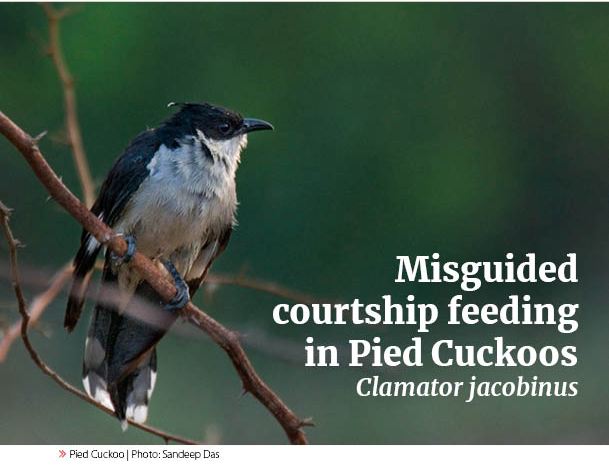On 12 February 2017, 0700hrs, we were doing the Kerala Bird Atlas survey for the dry season in Thiruvananthapuram district at sub-cell number [9, 6, 2]. Amayizhanghan thodu (8.51° N, 76.92° E) was a part of this subcell. We were recording the checklist for first 15 minutes (Waikar, 2017), walking along the southern bank of the thodu (rivulet).
On the opposite bank of the thodu, among the mid-level of the bushes/shrubs, we suddenly noticed four Pied Cuckoos Clamator jacobinus, sitting closely within half a meter from each other. Two birds out of the four appeared to be smaller in size. Their flight was clumsy and they often crash-landed into the branches with small hops. The larger birds appeared to be watching the smaller birds closely. We assumed the larger birds to be adults and the two smaller birds to be immature, perhaps fledged out of the same brood. There have been instances in the past where two Pied Cuckoos fledged out of the same babbler nest (Gaston, 1976).
Interestingly, one adult was seen feeding a hairy caterpillar to one of the presumed immature birds. Now, Pied Cuckoos are brood parasites of mostly Turdoides and Argya babblers (Payne & de Juana, 2019) but cuckoos are generally known to display misguided courtship feeding behavior, where the adults feed the young birds (not necessarily theirs) with an intention to mate. We do not think this instance has been documented earlier in Pied Cuckoos from India, though it has been reported from Africa (Payne, 2005). The only instance for an ‘Indian’ cuckoo where misguided courtship feeding was documented was in Grey-bellied Cuckoo (Kuriakose, 2012).
This is a strange instance where two adults were attempting to court two sub-adults; and Pied Cuckoos not being sexually dimorphic, possibly both adults in this instance were males.
We thank A K Sivakumar, Jaichand Johnson & Praveen J for their encouragement to write this note.
References
- Gaston, A. J. (1976). Brood Parasitism by the Pied Crested Cuckoo Clamator jacobinus. Journal of Animal Ecology 45 (2): 331–348. doi:10.2307/3878
- Kuriakose, J. (2012). An instance of an adult male Grey-bellied Cuckoo Cacomantis passerinus feeding a juvenile. Indian BIRDS 8 (1): 23.
- Payne, R. B. (2005). The Cuckoos. Oxford University Press. pp. 49, 320–325.
- Payne, R. & de Juana, E. (2019). Jacobin Cuckoo (Clamator jacobinus). In: del Hoyo, J., Elliott, A., Sargatal, J., Christie, D.A. & de Juana, E. (eds.). Handbook of the Birds of the World Alive. Lynx Edicions, Barcelona. (retrieved from https://www.hbw.com/node/54785 on 12 June 2019).
- Waikar, N. (2017). Website URL: https://ebird.org/india/view/checklist/S34398873 Accessed on 13 June 2019.
